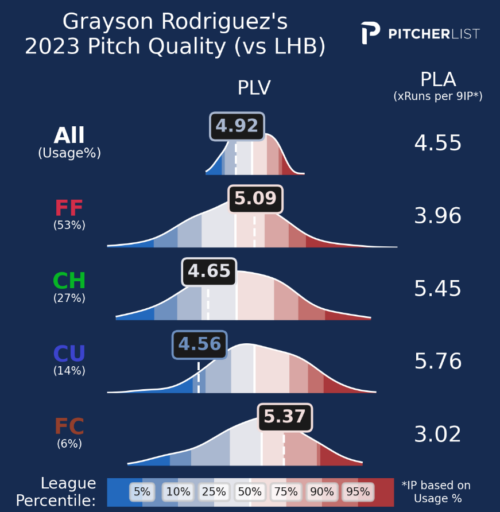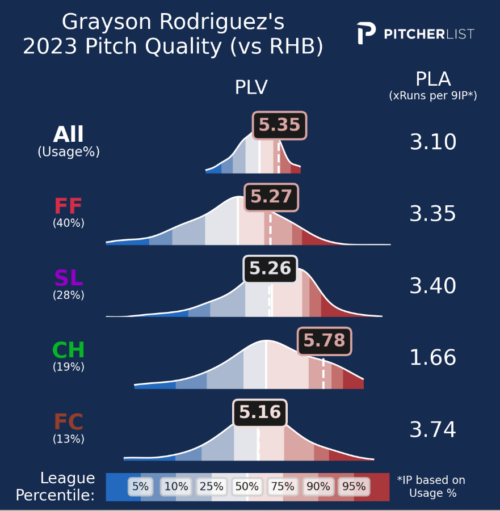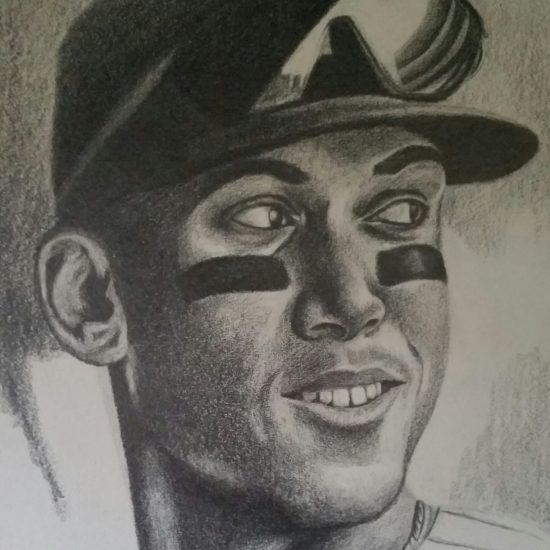This past offseason, Pitcher List introduced Pitch Level Value, or PLV, a new set of metrics. I won’t try to explain the machinations here, suffice it to say they provide us with a more intuitive way to evaluate player performance by dissecting outcomes at the individual pitch level. For example, was this a good pitch? And what might the expected result be based on the quality of the pitch? Basically, PLV provides better context by accounting for variance while assessing player performance. For a much more thorough explanation, be sure to read Nick Pollack’s primer on PLV here.
For reference, the definitions are listed below straight from the source. Grades are on a 20-80 scale.
Swing Aggression: How much more often a hitter swings at pitches, given the swing likelihoods of the pitches they face.
Strikezone Judgement: The “correctness” of a hitter’s swings and takes, using the likelihood of a pitch being a called strike (for swings) or a ball/HBP (for takes).
Decision Value (DV): Modeled value (runs per 100 pitches) of a hitter’s decision to swing or take, minus the modeled value of the alternative.
Contact Ability: A hitter’s ability to make contact (foul strike or BIP), above the contact expectation for each pitch.
Power: Modeled number of extra bases (xISO on contact) above a pitch’s expectation, for each BBE.
Hitter Performance (HP): Runs added per 100 pitches seen by the hitter (including swing/take decisions), after accounting for pitch quality.
Pitch Level Average (PLA): Value of all pitches (ERA Scale), using IP and the total predicted run value of pitches thrown.
Pitchtype PLA: Value of a given pitch type (ERA scale), using total predicted run values and an IP proxy for that pitch type (pitch usage % x Total IP).
For reference, here are the stabilization points, i.e., when the results tend to become a bit less noisy. They come courtesy of Kyle Bland, one of the very smart and talented people that helped develop PLV. You can follow him on Twitter @blandalytics.
For PLA and Pitchtype PLA, things tend to stabilize at around 500 pitches.
For hitters, it’s a little different.
SZ Judgment and Decision Value: 500 pitches, or roughly 32 games played.
Swing Aggression: 75 pitches, five games played. This is one of the variables that’s stable by now for most players.
Contact: 90 swings, about 12 games played.
Power: 95 Batted ball events, about 35 games played.
The last two depend a little bit on the type of hitter. For example, aggressive hitters will reach it more quickly relative to hitters who are passive and don’t swing as often.
As we head into week six, we’re starting to get a better sample size for SZ Judgment and Decision Value (500 pitches). I still think there is a bit of noise in batted ball data which makes evaluating hitters a little challenging. For that reason, I’m still mostly leaning on things like K/BB rates and SZ Judgment and Decision Value to get an idea of which hitters are performing well. I’ll mention a few hitters at the end that I think are worth keeping an eye on because of their DV grades.
We’re also getting enough of a sample size (about 500 pitches) to feel good about PLV and PLA for quite a few pitchers, at the very least the ones who started the year in the rotation.
Three weeks ago, we surveyed rookie hitters. This week, we’ll take a look at some rookie pitchers as it seems like we’re seeing quite a few of them debut lately. Of course, the sample size is flimsy with a couple of the recent call-ups but at the very least we can get a better description of the results, ie what went right and what didn’t and where we might want to see some improvement.
(Note: All PLV data is current through Thursday 5/4).
Brandon Pfaadt gained a lot of steam this past draft season after pacing the minors last season with 167 innings and 218 strikeouts. But then the D-Backs opted to hold him in Reno where he produced a 3.91 ERA, 1.18 WHIP, and 22.9% K-BB% through five starts. He debuted this past Wednesday which Ben Palmer detailed here. The results, well, they weren’t what you want. But, hey, it’s only one start.

The seven earned runs aside, one of the takeaways was that his heater returned just one whiff on 23 swings (4.3% whiff rate). The fastball didn’t grade out well at all with a 4.97 PLA and a quality-bad pitch (Q-BP%) of 3.7% (average is about 7%). But if you’re looking for a silver lining, he showed good control of his slider with a 58.8% zone rate. His slider graded out well with a 1.91 PLA. In the meantime, we’ll have to wait and see if he can rein in his fastball his next time out.
Miller v. Miller
This past Tuesday at Oakland, we were treated to two Millers for the price of one. Seattle’s Bryce Miller wasn’t off to a great start this year with a 6.41 ERA and 1.32 WHIP through four starts with the Double-A Travelers. However, he was much better there last season with a 3.20 ERA and 1.05 WHIP backed by a 20.6% K-BB% across ten starts. He got the call and breezed through six innings.

It’s not the deepest repertoire by any means, but it’s awfully hard to not be impressed by his fastball. The 24-year-old Texan averaged just over 95 with his fastball which returned a 40.4% CSW%. Even more impressive considering he threw it 70.4% of the time. Bryce’s fastball returned a dazzling 0.21 PLA. His cutter wasn’t too shabby either with a 2.56 PLA.
Not to be outdone, Mason Miller tossed seven no-hit innings with six punchouts. His fastball was also terrific and returned a 1.85 PLA on 46 pitches (46% usage). We’re only three starts in (267 pitches) but PLV is telling us that Miller is all kinds of legit based really on how great his fastball has been. So far, it’s returned a 2.23 PLA. Among starters with at least 400 pitches thrown, that ranks eighth behind Spencer Strider (1.70), Joe Ryan (1.81), Yusei Kikuchi (2.02), Drew Rasmussen (2.05), Gerrit Cole (2.07), Jacob deGrom (2.07), and Zack Wheeler (2.19).
Overall, Mason Miller has a 3.18 PLA. I’ll be curious to see if his slider, which returned a 3.40 PLA in his latest start against the M’s, continues to trend up. If it does, look out.
Also, if you missed it, be sure to check out Jake Crumpler’s breakdown of Mason’s debut.
In his latest start at Kansas City, Grayson Rodriguez struggled a bit, allowing six earned runs on eight hits. Overall, his arsenal grades out well, the low point being the curveball which he only throws 7% of the time.
One thing that might be worth monitoring is his splits. So far, he’s actually allowed a higher wOBA to RHB (.363) than LHB (.348) but his PLV marks against LHB leave a little to be desired. It looks like the changeup might be causing some problems.


Hunter Brown’s 10.6% walk rate last year in Triple-A (106 IP) made me hesitant to buy the hype. But he’s done really well so far while utilizing the throw-your-fastball-less approach (53% last year, 31% this season). The walks aren’t going away (10.7%) but his arsenal grades out well across the board, save for the splitter which he barely throws (2%).
His slider ranks sixth in PLA among all pitchers with at least 400 pitches thrown.
More Rookie Pitchers
Unfortunately, he was recently sent to the IL with a bad hamstring, but as Jack Foley recently detailed, Kutter Crawford is doing some interesting things. In a small sample (382 total pitches) his slider’s 0.92 PLA is second among all pitchers (200 pitch minimum). And his fastball is first (!!) at 1.00.
Speaking of surprising fastballs, Yusei Kikuchi’s heater has returned a 2.02 PLA that’s third among pitchers with at least 500 total pitches.
To Swing or Not to Swing
That is the question. Batted ball data can be difficult to evaluate especially this early. There is still a lot of noise. Yes, I’m a broken record. Anyways, one of the ways that PLV can really help us out is by providing us with a more intuitive way to assess hitters based on their individual swings and takes. Granted, not every hitter’s bat is created equal but at the end day simply choosing the right pitches to swing at is at the very least an important part of the puzzle. That’s where decision value (DV) comes in. On that note, we’ll end with a list of hitters who might not have great results at the moment but could be headed in the right direction based on having good DV grades. I’ll also include total pitches to note the sample size.
Alex Bregman (553 pitches, 75), Miguel Vargas (463, 75), Anthony Rendon (439, 70), Gunnar Henderson (424, 65), Ryan Noda (433, 65), George Springer (493, 60), Trey Mancini (439, 60), Alex Call (504, 60), Anthony Volpe (471, 60), Danny Jansen (283, 60), Alex Call (504, 60), Alejandro Kirk (397, 60), William Contreras (388, 60), Chris Taylor (360, 60).

